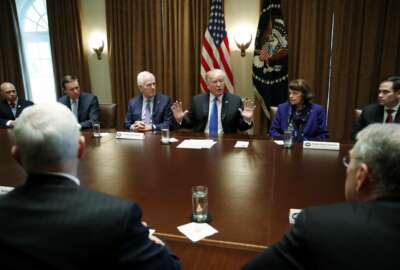
4 bots relieve NASA employees from doing ‘low-value’ work
Pam Wolfe, the chief of the Enterprise Services Division in the NASA Shared services office, said because of robotics process automation, her office can review...
Best listening experience is on Chrome, Firefox or Safari. Subscribe to Ask the CIO’s audio interviews on Apple Podcasts or PodcastOne.
The way NASA’s shared services office used to process grants was manual, full of paper and required the scanning of documents.
Many would consider that approach to be “low-value” work — the kind the Trump administration wants agencies to stop doing.
Pam Wolfe, the chief of the Enterprise Services Division in the NASA Shared services office, is showing how that transformation can be accomplished. She turned to robots to help employees get out of doing the monotonous work of processing paper.
“We get probably 75 of those [grant applications] in house weekly,” Wolfe said on Ask the CIO. “That has been an automation that has saved us a considerable amount of time for pretty mundane task that gives [our employees] the ability to focus on more analysis and value-added work.”
NASA worked with UiPath to implement robotics process automation (RPA) software and tools as part of how it is transforming the space agency’s approach to grants management.
Now the grant application are ready for NASA’s employees to begin processing when they get in each day instead of them having to print out, scan in and create the “case file.”
Jonathan Padgett, vice president of public sector for UiPath, said NASA has access to two kinds of bots—attended software, where the bot checks in with the employee, and unattended ones, where the bot just does the work.
“The software provides ability to emulate tasks that employees do at their desks,” he said in an interview. “The software interacts with other apps so it can be trained to do invoice processing and automate many of the mundane tasks employees usually do.”
Wolfe said NASA’s shared service office has implemented four bots, including one for agency CFOs doing funds distribution for the agency; one to do funds distribution for the shared services center; another one within the chief information officer’s office that creates procurement requests for the organization; and a fourth one that create cases in our for their human resources suitability reviews.
“All four of those projects were proofs of concepts. All were developed pretty quickly with user acceptance testing varying based on the nature of the automation,” she said. “Some user testing took one-to-two weeks, and others took a couple of months.”
Wolfe said her office started with 10 different ideas and went with four that were both quick wins and provided significant potential return on investment.
The biggest challenge for implementing the robotic process automation is NASA had to treat each one like they would an employee, meaning the software had to meet all the security requirements to access data and systems.
Wolfe said the bot had to have an agency user identification number, a login and password and it had to be able to encrypt and sign emails. Additionally, the bot had use NASA’s account management system to gain access to systems and use a virtual private network (VPN).
“One element that was challenging was the security training which basically a human doesn’t get access until they complete IT security training. A robot can’t complete it so we had to figure out how to overcome that,” she said. “There was a lot involved in credentialing a bot.”
NASA’s shared service center has several lines of business, ranging from financial management, procurement, human resources and some IT services, where automation could be helpful.
Wolfe said if she receives requests for automation that are similar from two or more centers or offices, the governance process kicks in to decide what makes the most sense.
Latest Technology News
She said part of the discussion about which processes NASA will automate comes down to getting big wins versus quick wins.
“We are looking at what are our savings in terms of the employees’ ability to do different work and more value added work. Some of the processes we are assessing have a large return on investment,” she said. “We’ve taken an approach to assessing the ideas that come in by establishing a service request in our system where anyone can submit an idea for automation and then that idea gets reviewed by that division chief. Once it goes through that process, we do an assessment in terms of how mature is the process, how complex, how many systems are required, what would it take to automate it and what kind of value do we see out of that automation in terms of cost savings or reduction in support requirements.”
Padgett said UiPath, which also is working with the Army and the Defense Information Systems Agency on RPA, said NASA centers can rent one or more bots bot to perform specific tasks, which lets them scale up or scale down as necessary.
He said NASA pays for the orchestrator, which manages the bots, the screen scraping technology, which captures the workflow process to automate, and then the bots, which are priced based on an attended or unattended model.
Wolfe said NASA spent about $150,000 for the four bots, which includes $20,000 for the orchestrator tool and the license for the bots cost about $5,000 per year, per bot.
“There are a lot of misnomers out there about what a bot can or can’t do. It’s understanding how to get past any security concerns, and then properly implement the bot,” Padgett said.
Copyright © 2025 Federal News Network. All rights reserved. This website is not intended for users located within the European Economic Area.
Jason Miller is executive editor of Federal News Network and directs news coverage on the people, policy and programs of the federal government.
Follow @jmillerWFED







